Masters 1881 – 1933
First Master of the ODG, Rev F.E.Robinson
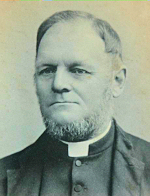
Rev F.E.Robinson was one of the founders of the Oxford DiocesanGuild of Church Bellringers. At the meeting in Reading on 13th November 1880 to consider the formation of a Guild, it was Robinson who, when it came to electing a committee, rose from the floor with a prepared list of names of who should be on it. The list included 7 clergymen and 7 well-known ringers. It included Robinson himself, who was both a ringer and a clergyman. At the inaugural meeting in Oxford on 17th January 1881 Robinson was duly elected as the Guild’s first master, a position that he held until his death 29 years later in 1910.
The Rev Francis Edward Robinson M.A. was vicar at Drayton between 1878 and 1908. He was born in 1833 in Begbroke, Oxon.
Shortly afterwards the family moved to Stonesfield where his father (also the Rev F.E.Robinson) was rector between 1834 and 1882. He was educated at Winchester and Exeter College, Oxford, graduating with a fourth class honours degree in 1853. He then worked in the Old Bank, Oxford, until 1867, first as a clerk, later as a partner. He learned to handle a bell as an undergraduate
After visiting Appleton in 1859 he discovered the joys of change ringing. Alfred White and his sons taught him change ringing so well that he rang his first peal that year. He made many attempts to ring a peal of Stedman and was so pleased to succeed in 1861 that he gave two tenors to Appleton at a cost of £254. He was ordained in 1868
After becoming a curate at Tubney he lodged in Appleton Vicarage. Lord Wantage presented him to the living in Drayton in 1878. To fulfil his ambition to become the first cleric to ring a peal on the bells of his own parish church he gave a treble and a tenor to augment the existing six at Drayton and went on to realise his dream. He was a competent conductor and had called peals of both Stedman Triples and Caters. He later became a member of the Ancient Society of College Youths. He was one of the founder members of the ODG in 1881 and became its First Master, a post he held until his death in 1910. In 1908 he moved to Wokingham where he remained until his death in 1910. Ringers subscribed to a memorial tablet to him in the cloisters of Oxford Cathedral. He is buried in Wokingham All Saints churchyard.
Robinson tried to retire from the post several times during the last ten years, when he had several illnesses but each time the committee persuaded him to stay on. This pattern of long serving masters, all of whom were clerics, lasted for nearly a century:
Revd C W O Jenkyn 1910 – 1933, Canon G F Coleridge 1933 – 1946 and Canon C E Wigg 1946 – 1973. Since the 1970s however, Guild masters have all been laymen and they have served for much shorter terms of office, with 7 masters covering a period of 30 years.
Photographs of Robinson (and Jenkyn who succeeded him) still hang in many ringing towers in the Oxford Diocese, including the ringing chamber at All Saints Wokingham where you can also find F.E.Robinson’s grave in the churchyard.
Cyril Walford Osborn Jenkyn
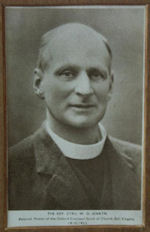
No description of bellringing in East Garston would be complete without reference to the late Rev. C.W.O. Jenkyn.
Cyril Walford Osborn Jenkyn was born in East Garston in 1874, the son of W. 0. Jenkyn, who was the vicar of East Garston from 1870 to 1901. Rev. Cyril Jenkyn learned bellringing at East Garston and Lambourn as a boy. He rang his first peal, a memorised sequence of 5,040 changes usually lasting over three hours, at Cambridge and became branch chairman and librarian of the Oxford Diocesan Guild of Church Bellringers.
He was Deputy master of the Guild 1905 – 1910 and was elected Master in 1910, a post he held until his death in 1933. Cyril Jenkyn liked to ring heavy bells: these included the tenors at Southwark and St. Mary le Bow which weigh over two tons (2,000kg) each. His frequent visits to the many towers in the area were eagerly awaited by the local ringers. Cyril’s photograph hangs in All Saints and many other belfries in the area, and there is a memorial to him at Christ Church Cathedral, Oxford. This remarkable man is still remembered today, not only for his many achievements but also for his friendliness and infectious enthusiasm. The model bell he made is still being used today.
Masters 1933 – 1973
Canon G.F. Coleridge
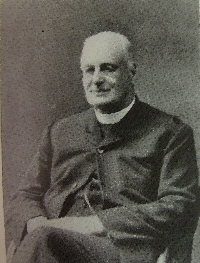
Coleridge was born in 1857 in Cadbury, Devon, where his father held the living. He learned to handle a bell there when he was 17.
He graduated from Keble College in 1884 and went to Caversham for his first curacy, where he was instrumental in getting the Caversham ring augmented from 6 to 8 bells in 1891. While an
undergraduate he was first Secretary of the Oxford University Society, then Master. He was vicar of Crowthorne, Berks from 1904 until his death on 22 November 1949. He was active in the formation of the ODG and Secretary of the Reading branch for 10 years before becoming Chairman of the Sonning Deanery branch from 1923 to 1947.
He was President of the Central Council from 1921 to 1930 and made a Vice President of the ODG in 1927.
He rang 273 peals, many with F.E.Robinson and enjoyed long lengths taking part in the 15041 Stedman Caters at Appleton.
After 1933 he was no longer able to make bell inspections and this job devolved to the General Secretary. His bouts of arthritis prevented him attending all the Branch meetings.
When he died there was much argument as to a suitable memorial. Everyone agreed there should be a tablet in Christ Church Cloisters next to those for previous Masters. It was also suggested that the two trebles of the Cathedral should be recast. The work was finally completed in 1954. The two new trebles cost £157 and the two tablets, one in the cloisters, and one in the ringing room cost £60.
Canon Charles Elliott Wigg
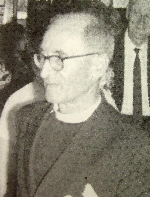
Charles Elliot Wigg was born at Ferry Hinksey in 1908. After attending Oxford High School he went up to Keble College. While there he learned to ring and rang his first peal in 1931. He was Treasurer of the University Society in 1930. He completed his training for the Ministry at Wycliffe Hall and then took a curacy at High Wycombe. In 1933 he was appointed Deputy Master of the ODG to assist the Master, Canon Coleridge, who was then nearer eighty than seventy and said he felt the job of Master needed a younger man.
On May 15th 1935 he participated in the first peal of Grandsire Triples ever rung by eight priests of the church at East Hagbourne. It was rung for the silver jubilee of King George V. A plaque in their ringing chamber commemorates this peal.
In 1941 he was vicar of Chearsley and got married. Members collected for a wedding present of a chiming grandfather clock with an inscribed plaque. He was elected Master of the ODG in 1946. When Winston Churchill died early in 1965, as his funeral train passed through Oxford, Frederick Sharpe and Canon Wigg raised Great Tom frame high and tolled him. After the interment in Bladon Canon Wigg participated in a peal of plain Bob Minor on the Bladon bells. In November 1961 Elliot Wigg was made an Honorary Canon of Christ Church in recognition of his services to the diocese in the art of ringing. In 1968 he moved from Wavendon, Bucks, on the Bedfordshire border to Hook Norton, Oxon. Although he was never entirely fit there, in 1971 he was pleased to conduct the marriage ceremony of the new general Secretary, Bill Butler and Jennifer Barker in Thatcham. In 1973 he took a less arduous living in Launcells, Cornwall, but his health continued to deteriorate and he returned to live at Moreton-in-Marsh, where he died in hospital on 8th March 1976.
A memorial plaque was placed in the cathedral cloisters and there is another joint one with Frederick Sharpe in Nether Winchenden.
Fred Sharpe 1905 – 1976
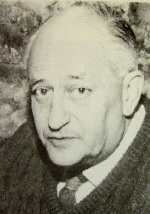
Fred Sharpe was Master of the Oxford D.G., a past President of the Central Council and connected with a great many committees and organising bodies and librarian for the C.C.
He was an outstanding personality in a number of different ways. His numerous interests and his unfailing ability to assist anyone who needed his help and advice, made him one of the busiest of individuals. His amazing collection of bells and their appurtenances, together with detailed records and historical details, were second to none in the world and this knowledge came from a lifetime of interest and study. Fred’s expert knowledge of strains and stresses on towers and belfries was invaluable and he was sought by many church authorities to give his opinion before decisions were made. His leadership in handbell ringing and his patience when teaching young and old to handle and to try out simple tunes were legendary, whilst his books on the bells of several counties are to be found on many ringers’ bookshelves.
The library of the Central Council1, a collection of several hundred volumes and pamphlets, was held in Fred’s ‘den’ at Launton, which was reorganized shortly prior to his death to ease the cramped conditions, as he found the increasing collection made access difficult. The hospitality always extended to visitors to his home was well known; “Come across to the Den,” he would say and you would leave the warm welcome that Janie and Elizabeth were giving you and walk past the bell-wheel trellis to the little stone building beside the house. This was where it all happened: models, photographs, plaster-casts of bells and bell inscriptions on the walls, with a College Youths’ certificate to remind you that this was a good practical ringer apart from all else; the little brown case which had been up so many hundreds of towers with him, containing his white dust-coat, camera and flashgun, torch, callipers, tuning-forks, rules, plasticine and dozens of pencils; the neat desk with the day’s paper-work under a paper-weight replica of some Rudhall lettering; and the books.
There are books about bells and some of the very best of them are his own work; Cardiganshire, Berkshire, Oxfordshire, Radnorshire and Herefordshire, completed not long before his death, along with slimmer ones for Guernsey and the Scilly Isles; books about bells in several languages and of several ages; shelf after shelf of the uniform loose-leaf books containing the details of thousands of towers all written out in his beautiful, bold handwriting and the photographs, mounted and framed in ruled red lines, with their negatives in a transparent envelope on the back; bells, towers, frames, gear, foundries at home and overseas. There, too, was stored experience of the man who carried on in the study of tower structures and bell stresses where E. H. Lewis left off and brought to it his own lifetime’s practical expertise in repairing ancient buildings. And more still, for Fred had a musical ear of quite exceptional sensitivity and an amazing range of manual skills.
But the books were not all about bells. There were shelves of music books for the choirmaster, the singer and arranger of hand-bell music; shelves of topography for an indefatigable traveller; architecture for a professional builder who never ceased to study and love old buildings; railway history to go with some beautifully-made model railway stock in his workshop; and religious books for the busy Lay Reader who seldom passed a Sunday without helping out some neighbouring parish and helped to hold the fort through some long vacancies in his own beloved Launton.
Then there were the handbells and what can one say about them? Nested in their travelling cases or hanging in racks are handbells by almost every known British maker in the last three centuries, searched out, found, identified, refitted and tuned to form a beautiful and unique set which the Launton Handbell Ringers have taken to recitals up and down the kingdom.
This is no magpie hoard, collected for the sake of collecting. The handbells were to be rung; the pictures mounted for display at exhibitions and lectures far and wide; the knowledge and experience set down for the benefit of anyone who needed it. This Den was not a hermit’s cell, where one man retired from the world: Fred’s friends were always welcome to share it and its treasures and to share a bottle from the crate, artfully hidden under a box in the corner. Few experts in any field can have been so unfailingly generous with their knowledge as Fred Sharpe and many, many people are trying to do the kind of work which he did because of the encouragement and practical help with which he set them on the road. Nor was he ever still for very long, here in the Den or anywhere else: few people can have had such a keen sense of duty to push them forward or such a delight in their work to make it a pleasure. And for this we can be so deeply thankful that his energetic soul led him to achieve so much permanent good which we have for always and his realistic wisdom which provided for its preservation. His collection will remain for the use and benefit of all who need to use it and in thousands of communities large and small there are towers restored or saved, bells kept sounding or sounding again, ringers, clergy, church people working and worshipping and grateful for his help and inspiration.
Fred was born in Launton in 1905 and, though not an exceptional method ringer himself, he had been captain of the local band since 1927 and, where necessary, could ring two bells. He had been associated with Launton church from boyhood as chorister, server, ringer since 1920 and churchwarden since 1932 and in 1955 became a licensed lay reader in the Diocese of Oxford.
Fred was a member of the Central Council from 1939, first as an honorary member because of his knowledge of bells and belfries and from 1954 as a life member. He became a member of the Towers and Belfries Committee in 1946 and convener in 1952, a post he was to hold for some 20 years. He was librarian from 1953 to 1958 and again from 1969 until his death in 1976.
A memorial service in the Cathedral, Oxford, took place shortly before another, that of Elliot Wigg, another past Master of the Oxford Guild.
1At the time of writing the Central Council Library is housed in Herefordshire with the Central Council Librarian, Dr John Eisel.
2The Sharpe collection of books and bells is held at the Pitt Rivers Museum, Oxford, under the stewardship of the Sharpe Trust.
The Sharpe Trustees website contains details of the collection and provides information on ordering past publications.
The above is a digest of articles in The Ringing World of 1976, some forming an obituary to Fred Sharpe by the Editor, Charles Denyer, the Reverend Prebendary John G. M. Scott and Edwin A. Barnett. Permission for the reprinting of these articles has been granted by the current Editor, Robert Lewis.
Notes
- Memorials to him can be seen in Oxford Cathedral Cloisters and in Nether
Winchenden. - The Sharpe Trustees sell the remaining stock of his books about
bells. - The Sharpe Collection is stored in the Pitt-Rivers Museum in
Oxford.It may be viewed by prior appointment. Contact Tim Pett for
details.
Masters 1976 – 2003
In 2003 it was suggested that all the past
Masters of the ODG might get together and ring a peal.
The peal was rung at Great Tew, Oxon on Sunday 23 March
2003.
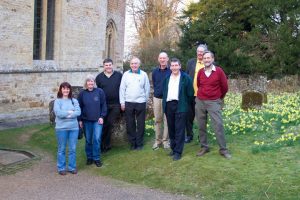
Graham Clifton, John Wells, Nigel Harrison,
Ken Davenport, Bill Butler,
Jon Chamberlain
5152 Yorkshire Surprise Major.
- William Butler Past Master, Conductor
- Patricia M Newton Past Master
- Sally A Austin Area Steward
- Nigel P Harrison Guild Secretary
- Kenneth Davenport Past Dept. Master
- Jonathan Chamberlain Dept Master
- E John Wells Past Master
- Graham J Clifton Guild Master
